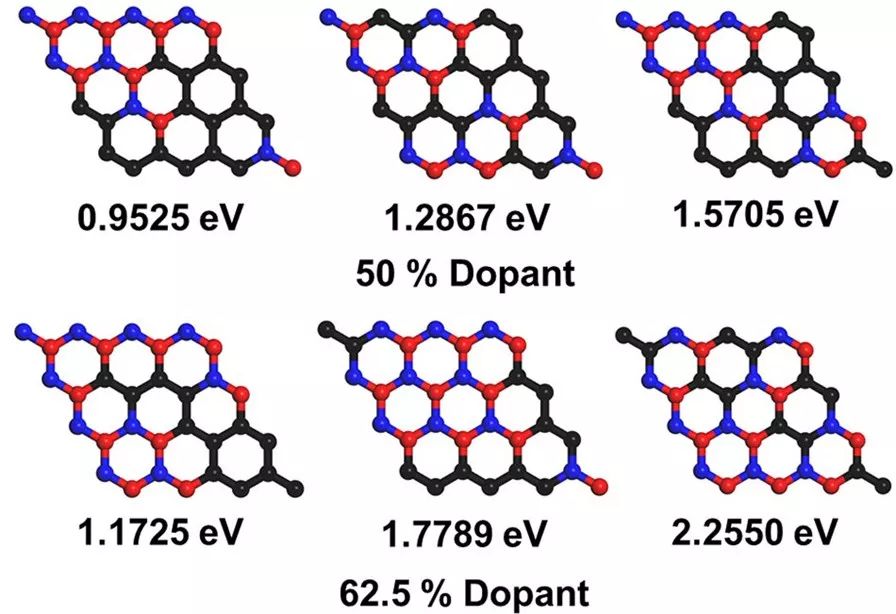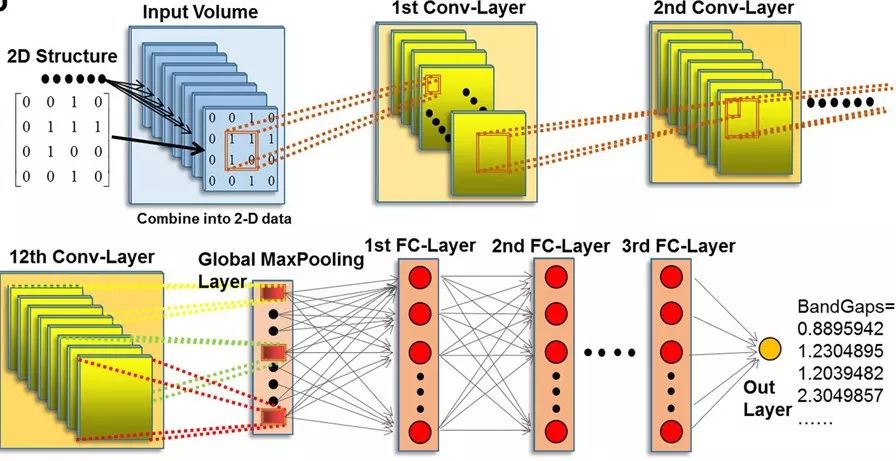科技工作者之家
科技工作者之家APP是专注科技人才,知识分享与人才交流的服务平台。
科技工作者之家 2019-03-28
石墨烯作为第一个家喻户晓的二维材料,其机械、热和电性能依赖于晶界的构型。石墨烯以氢、氮、硼等原子掺杂后,可进一步调整其磁性能或电性能。这些性质不仅取决于掺杂剂的类型和掺杂浓度,还很大程度上取决于掺杂剂构型。虽然理论研究的功能已经远超实验研究,但石墨烯的掺杂剂构型数量远远超过可实际计算的量,造成计算成本极为高昂。例如,将硼-氮(B-N)对与仅6×6超级单元系统的石墨烯单层杂化会产生数十亿种可能的构型。因此,对于这样小的系统,要从所有可能性中获得优化特性也完全是不切实际的。
来自美国密苏里大学机械与航空航天工程系的Jian Lin教授和电气工程与计算机科学系的Jianlin Cheng教授等,设想采用级联卷积网络(CNNs),包括VGG16卷积网络、残余卷积网络和他们新构建的连接卷积网络,来预测杂化石墨烯和h-BN的电子特性。以深度学习的 “前辈”、主流机器学习算法的支持向量机作为基准对照,他们发现,经过结构信息和从头算密度泛函理论(DFT)计算的带隙训练后,CNNs能够精确预测任何给定构型的杂化石墨烯和氮化硼(BN)对的带隙。
预测的4×4和5×5超级单元的带隙精度R2> 90%,均方根误差为~0.1 eV。预测精度如此之高的一个主要原因是其所开发的材料描述符。这种描述符系统能够定性和定量地捕获构型状态的特征,其中结构中的每个原子影响其相邻原子,使得这些局域化的原子簇共同确定整个结构的带隙。辅以良好调整的超参数和精心设计的描述符,CNNs可以提高预测精度。考虑到自下而上化学合成的掺杂石墨烯的精确到原子尺度的结构已经在实验中获得,这项工作为将来石墨烯和其他2D材料的构型及其性质的研究提供了基础,也将引起人们更广泛的兴趣,将这些描述符系统和级联卷积网络模型用来解决材料领域其他机器学习所无法解决的问题。
该文近期发表于npj Computational Materials 5:26 (2019),英文标题与摘要如下,点击左下角“阅读原文”可以自由获取论文PDF。

Bandgap prediction by deep learning in configurationally hybridized graphene and boron nitride
Yuan Dong, Chuhan Wu, Chi Zhang, Yingda Liu, Jianlin Cheng & Jian Lin
It is well-known that the atomic-scale and nano-scale configuration of dopants can play a crucial role in determining the electronic properties of materials. However, predicting such effects is challenging due to the large range of atomic configurations that are possible. Here, we present a case study of how deep learning algorithms can enable bandgap prediction in hybridized boron–nitrogen graphene with arbitrary supercell configurations. A material descriptor that enables correlation of structure and bandgap was developed for convolutional neural networks. Bandgaps calculated by ab initio calculations, and corresponding structures, were used as training datasets. The trained networks were then used to predict bandgaps of systems with various configurations. For 4 × 4 and 5 × 5 supercells they accurately predict bandgaps, with a R2 of >90% and root-mean-square error of ~0.1 eV. The transfer learning(TL) was performed by leveraging data generated from small supercells to improve the prediction accuracy for 6 × 6 supercells. This work will pave a route to future investigation of configurationally hybridized graphene and other 2D materials. Moreover, given the ubiquitous existence of configurations in materials, this work may stimulate interest in applying deep learning algorithms for the configurational design of materials across different length scales.

扩展阅读
npj: 铁电材料大电-光常数—应变调控
npj: 纳米孪晶的软硬变化
npj: 固体稳定性—分解反应DFT预测
npj: 密度泛函理论—固态赝势的计算
npj:机器学习—热电材料的回过与预测
来源:zhishexueshuquan 知社学术圈
原文链接:http://mp.weixin.qq.com/s?__biz=MzIwMjk1OTc2MA==&mid=2247496447&idx=3&sn=0dc3fff9dc2a25ecda03d697a4ce7245&chksm=96d40c00a1a385166dbfdb08cb5f7bc552a3c74c132deea5735fb07eb4538956388191c7c10f&scene=27#wechat_redirect
版权声明:除非特别注明,本站所载内容来源于互联网、微信公众号等公开渠道,不代表本站观点,仅供参考、交流、公益传播之目的。转载的稿件版权归原作者或机构所有,如有侵权,请联系删除。
电话:(010)86409582
邮箱:kejie@scimall.org.cn

干货:三维石墨烯网络结构的合成及应用

铜纳米颗粒/石墨烯核壳结构材料催化研究获进展

实现石墨烯纳米结构原子级精准的可控折叠

机器学习软件可以预测细菌行为

量子增强机器学习:量子经典混合卷积神经网络

人工智能被用于重构量子系统,为量子研究提供新途径

PRL: “类五角石墨烯状”结构的高温超导体

新型机器学习工具可在疾病爆发前标记危险的细菌

人工智能可高度准确判断自杀倾向

城市环境所在石墨烯气凝胶结构调控方面取得进展